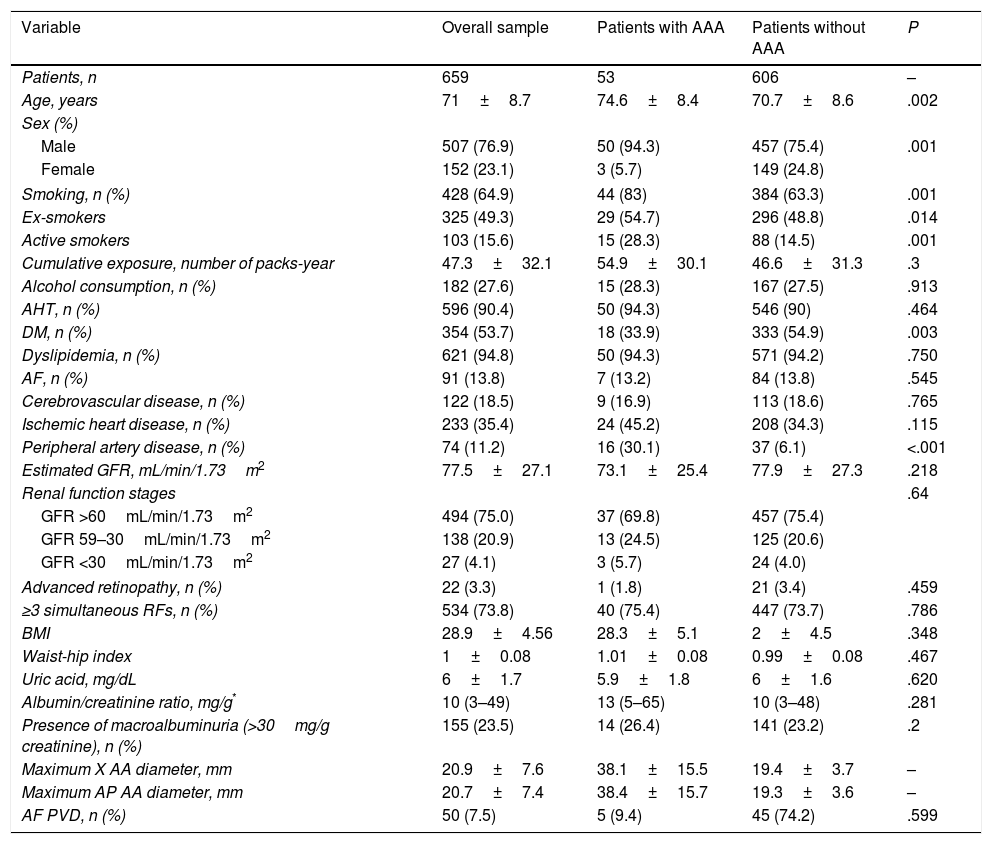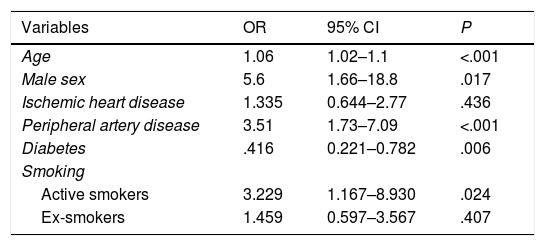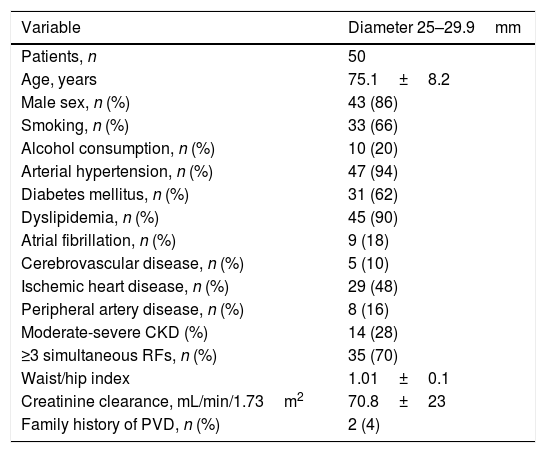To determine the prevalence of abdominal aortic aneurysm (AAA) (arterial diameter ≥30mm), in patients with high or very high cardiovascular risk (CVR) and to evaluate their clinical features.
Patients and methodsObservational, cross-sectional and multicentric study conducted in Spanish Internal Medicine Services. We enrolled men with age >55 years and women >65 years who had a high or very high CVR.
ResultsThe study included 659 patients. The prevalence of AAA was 8% (53 patients). 76.9% were male with a mean age of 71±8.7 years. The multivariate analysis showed an association between AAA and age (OR: 1.06; 95% CI: 1.02–1.1; P<0.01), male sex (OR: 5.6; 95% CI: 1.6–18.8; P=0.01), active smoking (OR: 3.22; 95% CI: 1.16–8.93; P=.024) and peripheral arterial disease (OR: 3.51; 95% CI: 1.73–7.09; P<0.01). Diabetes mellitus was an independent protective factor (OR: 0.41; 95% CI: 0.22–0.78; P=0.06). Those with subaneurysmal dilatation of the abdominal aorta (diameter 25–29.9mm) presented similar features as patients with AAA.
ConclusionsThe prevalence of AAA in patients with high CVR is high. Ultrasound screening can be performed by general practitioners. Men >65 years with elevated CVR could benefit, particularly in the presence of active smoking or peripheral arterial disease.
Determinar la prevalencia de aneurisma de aorta abdominal (AAA), definido por un diámetro arterial ≥30mm, en pacientes con alto o muy alto riesgo cardiovascular (RCV) y evaluar sus características clínicas.
Pacientes y métodosEstudio observacional, transversal y multicéntrico realizado en servicios de Medicina Interna del país a varones con edad >55años y mujeres >65años que tenían un RCV alto o muy alto reclutados durante 24meses.
ResultadosSe incluyeron 659 pacientes. La prevalencia de AAA fue del 8% (53 pacientes). El 76,9% fueron varones, con edad media de 71±8,7años. El análisis multivariante demostró asociación entre AAA y la edad (OR: 1,06; IC95%: 1,02-1,1; p<0,01), el sexo masculino (OR: 5,6; IC95%: 1,6-18,8; p=0,01), el tabaquismo activo (OR: 3,22; IC95%: 1,16-8,93; p=0,024) y la arteriopatía periférica (OR: 3,51; IC95%: 1,73-7,09; p<0,01), siendo la diabetes mellitus un factor protector independiente (OR: 0,41; IC95%: 0,22-0,78; p=0,06). Los pacientes con dilatación subaneurismática de la aorta (diámetro de la aorta abdominal 25-29,9mm) presentaban similares características que los pacientes con AAA.
ConclusionesLa prevalencia de AAA en pacientes de alto RCV es elevada. El cribado ecográfico puede ser realizado por médicos generalistas. Pueden beneficiarse de un cribado oportunista los varones de más de 65años, con RCV elevado, especialmente si presentan tabaquismo activo o arteriopatía periférica.
Article
Diríjase desde aquí a la web de la >>>FESEMI<<< e inicie sesión mediante el formulario que se encuentra en la barra superior, pulsando sobre el candado.

Una vez autentificado, en la misma web de FESEMI, en el menú superior, elija la opción deseada.

>>>FESEMI<<<










